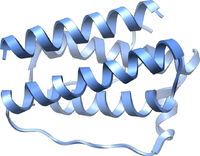
Photo from wikipedia
Objective The adipose-derived hormone leptin plays an important role in regulating body weight and glucose homeostasis. Leptin receptors are expressed in the central nervous system as well as peripheral tissues… Click to show full abstract
Objective The adipose-derived hormone leptin plays an important role in regulating body weight and glucose homeostasis. Leptin receptors are expressed in the central nervous system as well as peripheral tissues involved in regulating glucose homeostasis, including insulin-producing β cells of the pancreas. Previous studies assessing the role of leptin receptors in β cells used Cre-loxP to disrupt the leptin receptor gene (Lepr) in β cells, but variable results were obtained. Furthermore, recombination of Lepr was observed in the hypothalamus or exocrine pancreas, in addition to the β cells, and Lepr in non-β cells may have compensated for the loss of Lepr in β cells, thus making it difficult to assess the direct effects of Lepr in β cells. To determine the significance of Lepr exclusively in β cells, we chose to selectively restore Lepr in β cells of Lepr null mice (LeprloxTB/loxTB). Materials and methods We used a mouse model in which endogenous expression of Lepr was disrupted by a loxP-flanked transcription blocker (LeprloxTB/loxTB), but was restored by Cre recombinase knocked into the Ins1 gene, which is specifically expressed in β cells (Ins1Cre). We bred LeprloxTB/loxTB and Ins1Cre mice to generate LeprloxTB/loxTB and LeprloxTB/loxTBIns1Cre mice, as well as Leprwt/wt and Leprwt/wtIns1Cre littermate mice. Male and female mice were weighed weekly between 6 and 11 weeks of age and fasting blood glucose was measured during this time. Oral glucose was administered to mice aged 7–12 weeks to assess glucose tolerance and insulin secretion. Relative β and α cell area and islet size were also assessed by immunostaining and analysis of pancreas sections of 12–14 week old mice. Results Male and female LeprloxTB/loxTB mice, lacking whole-body expression of Lepr, had a phenotype similar to db/db mice characterized by obesity, hyperinsulinemia, glucose intolerance, and impaired glucose stimulated insulin secretion. Despite restoring Lepr in β cells of LeprloxTB/loxTB mice, fasting insulin levels, blood glucose levels and body weight were comparable between LeprloxTB/loxTBIns1Cre mice and LeprloxTB/loxTB littermates. Furthermore, glucose tolerance and insulin secretion in male and female LeprloxTB/loxTBIns1Cre mice were similar to that observed in LeprloxTB/loxTB mice. Analysis of pancreatic insulin positive area revealed that restoration of Lepr in β cells of LeprloxTB/loxTB mice did not prevent hyperplasia of insulin positive cells nor did it rescue Glut-2 expression. Conclusion Collectively, these data suggest that direct action of leptin on β cells is insufficient to restore normal insulin secretion and glucose tolerance in mice without leptin receptor signaling elsewhere.
Journal Title: Molecular Metabolism
Year Published: 2017
Link to full text (if available)
Share on Social Media: Sign Up to like & get
recommendations!